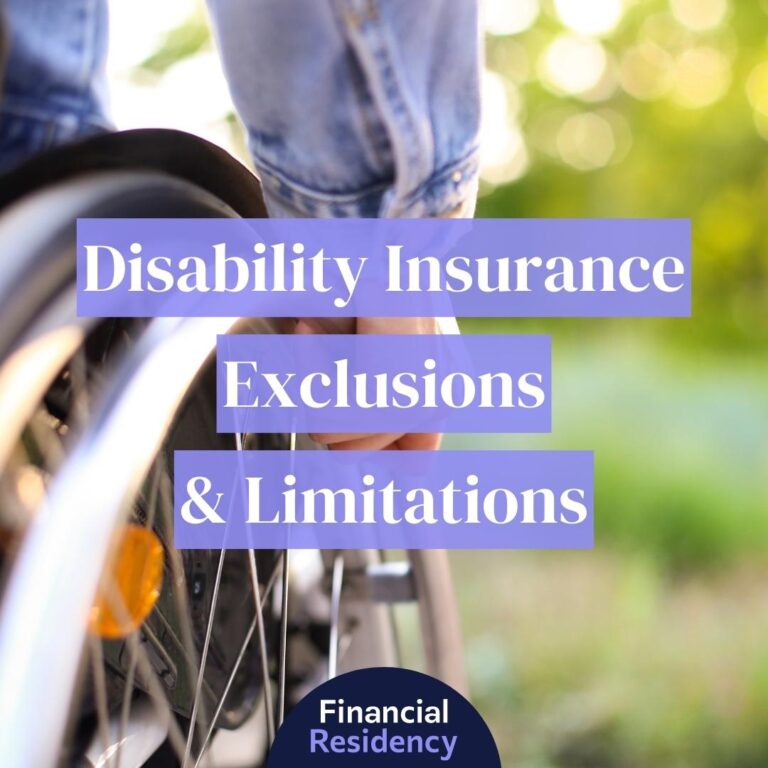Knowing how much disability insurance you need is essential. It should be a part of every doctor’s financial plan, but the amount each person needs will likely vary depending on your specialty and experience.
Here’s what you should consider when choosing the right amount of coverage.
What Is Disability Insurance?
Your income is your greatest asset, so you must protect it. If you lost your income, what would you use to make ends meet?
Disability insurance typically pays between 60% to 70% of your income during your disability, depending on the type of policy you purchase. So it’s integral to any financial plan to ensure you can make ends meet even if you cannot work.
Calculating How Much Disability Insurance I Need
Determining how much disability insurance you need is the key to purchasing the right policy. Most people buy policies that cover 60% to 70% of their income because they have lower costs when disabled.
For example, when you cannot work, you’ll likely save money on the following:
- Gas and wear and tear on your car due to a lack of commute
- Clothing and other gear required for work
- Food due to not having lunch and coffee breaks
- Taxes due to less income
To determine the amount of disability insurance you need, consider the following factors.
1. Evaluate Monthly Expenses
First, evaluate your monthly expenses, considering many may decrease when you cannot work.
Include fixed expenses such as your mortgage or rent, utilities, transportation expenses, debt payoff, household maintenance, and insurance, such as health, life, and home.
Next, consider expenses that may increase or decrease during your disability, including:
- Groceries
- Health care
- Clothing
- Travel
- Entertainment
- Savings
- Charitable contributions
Consider what you might change if you become disabled. For example, if you live in a high-cost area because it’s close to your practice and you can afford it with your current income but become disabled, you might downsize into something more affordable on your lower salary.
Also, consider expenses that may increase, such as healthcare. Depending on your disability, you may need more ongoing care or therapy that may increase your healthcare costs.
2. Factor In Employer-Provided Policies
Many employers offer a group disability insurance policy. You might pay the premiums with before-tax dollars, or your employer may cover the cost.
Employer-sponsored disability insurance usually has a much lower coverage amount that isn’t enough for you to live on, but it can supplement your disability income. Keep in mind, however, these policies aren’t usually portable. If you change jobs, you’ll likely lose the coverage.
3. Estimate Expected Income
Calculate all income you expect to receive if disabled before purchasing a new disability insurance policy, including existing group policies and Social Security. Also, consider any other income, such as investments or savings.
4. Calculate the Difference
Subtract your expected expenses from your expected income; the difference is what you should consider for an individual disability policy.
Example 1
Let’s look at an example of a resident making $60,000 a year with a spouse and baby. The family enjoys traveling, pays childcare expenses, and owns a starter house to live near where they work.
The couple relies on both spouses’ incomes and likes to spend money on entertainment, clothing, and things around the house.
The resident doesn’t yet have a group disability insurance policy and needs an individual policy to protect his income if he cannot work.
- Expenses: First, the couple must consider their expenses. They don’t think they’d move if the resident became disabled because they live in a starter home. However, the couple would no longer pay for childcare with one parent home. The couple would also likely cut down on spending on entertainment and travel, especially if the disability didn’t allow for it.
- Income: The couple relies on both spouses’ income. Neither has a group disability policy, and they’ve just started building their savings. They may have a little residual income from a few investments, but they’re just starting out.
- Amount of Insurance: This couple needs as much as 70% income replacement should the resident become disabled. Since he makes $5,000 a month, he purchases $3,500 in monthly disability payments. This money would be tax-free because the policy would be paid for with after-tax dollars.
Example 2
Our following example is a more established couple. The wife is a doctor and has been practicing for five years. She makes $250,000 a year and lives in an affluent neighborhood with her family, including three kids, in a large house. The kids keep the family active with their activities and travel, and the parents have some expensive hobbies themselves.
The couple has a significant amount of money in savings to cover their expenses for a few months, and they also have a small amount of residual investment income monthly.
The doctor’s practice provides group disability insurance, so they figure that into their calculations when choosing the right amount of disability insurance.
- Expenses: This couple has more expenses than the couple in my first example because they have a larger family, a higher income, and live in a larger house. They’ve established their lifestyle and depend on the doctor’s salary as her partner stays home with the kids. The couple discussed moving if the doctor became disabled so they could continue most of their lifestyle but not live excessively. However, looking at their expenses, they need at least 60% of their income covered to make ends meet.
- Income: Looking at the big picture, this couple has a better financial situation. They have six months of the most necessary expenses saved, so if the doctor became disabled, they’d be okay for that time. They also get some income from their real estate and stock market investments. They don’t rely on the income, but they know if the doctor’s income stopped, they’d still have money trickling in monthly.
- Amount of Insurance: The doctor’s monthly income is currently $20,833 a month. If she became disabled, they wouldn’t need 100% of that amount, but they’d still need a decent amount. However, the doctor has a group policy from her practice. The employer covers the cost, and the policy has a monthly cap of $5,000. Since 60% of $20,833 is $12,500, $5,000 isn’t nearly enough to cover the doctor and her family long-term. Taking into consideration the six months of savings and the $1,000 or so they bring in from investments monthly, they purchase long-term disability insurance that would provide $6,500 a month long-term.
Disability Insurance Cost Considerations
Determining how much disability insurance you need is essential, but so is understanding the factors affecting its cost. The more insurance you need, the more it will usually cost. When deciding on coverage, take the following factors into account to help make your decision.
Age and Health
The younger you are when you purchase disability insurance, the less it will cost. In addition, you’re more likely to have fewer health conditions when you’re younger.
This is especially important if you know you’ll have a high income as an established doctor. If you secure a policy in your residency, you’ll lock in lower rates, but with the right rider, be able to increase the coverage.
Income/Occupation
The amount of money you must replace, and your occupation affect your disability insurance cost. As I said earlier, the more coverage you need, the more it will cost.
The more dangerous your occupation is, the higher premiums you’ll pay because of the likelihood of a disability, which may affect how much coverage you purchase.
Benefit Period
The longer you’ll receive benefits, the higher premiums you’ll pay. Insurance companies take a higher risk committing to paying you benefits for longer.
For example, if you purchase a policy that would pay benefits for two years versus one that pays through retirement, you’ll pay lower premiums and may be able to afford higher coverage.
Elimination Period
The elimination period is the waiting period or the time you won’t get benefits even when you’re disabled. For example, a 6-month elimination period means you won’t receive benefits for the first six months.
The longer your elimination period, the lower your premiums and the more coverage you can afford.
Short vs. Long-Term
Short-term disability insurance covers you for one year or less if disabled; long-term insurance covers you for longer. The average long-term policy covers you through retirement, usually from age 65 to 67. However, long-term policies cost more and can affect how much coverage you can secure.
Pre-Tax vs. Post-Tax Policies
You must always take taxes into account when considering the disability coverage you should purchase. If you have a group policy, you may owe taxes on the income, increasing your cost. You’ll know if you owe taxes if you don’t pay the premiums or if the income used to pay the premiums is pre-tax.
If you owe taxes on the income, you might need more coverage to make your net income
sufficient.
Monthly vs. Annual Premiums
Some disability insurance companies offer a discount of as much as 5% if you pay your premiums annually. This can reduce the coverage you must purchase if you have to pay less.
Own vs. Any-Occupation Coverage
Doctors should always consider own-occupation coverage. It increases the cost but provides income replacement if you cannot work your current occupation. Any occupation only pays out if you are so disabled that you can’t work any job.
If money is tight, you might consider any occupation to get more coverage but play with the numbers to see which works best.
Non-Cancelable Coverage
Non-cancelable coverage costs more but ensures the insurance company cannot cancel your policy. Consider this in your costs when determining how much disability insurance you need.
Frequently Asked Questions
Choosing the right amount of disability insurance is a big decision. Here are some further questions to consider.
What Does My Disability Insurance Cover?
Disability insurance covers you if you are unable to work. The exact conditions, length of coverage, and terms vary by policy. When selecting a policy, read the fine print and speak with a representative to answer any questions you may have so there is no misunderstanding about what you’re owed should you become disabled.
Learn More:
Do 100% Coverage Policies Exist?
No insurance company offers 100% coverage. The average disability coverage is for 60% of your income but typically ranges from 50% to 70% of your income.
Will My Benefits Be Taxable?
Your benefits may be taxable depending on how you pay for them. For example, if someone else pays the premiums or you pay with before-tax dollars, you must pay taxes on the income. However, if you pay with after-tax funds, the income is tax-free.
Are There Any Conditions Not Covered Under Disability Insurance?
Each insurance company has different terms, but most have some conditions not covered under disability insurance. These often include certain preexisting conditions and self-inflicted injuries.
So, How Much Disability Insurance Do You Need?
So, to answer, ‘How much disability insurance do I need?” you will need to dig deeper into your and your family’s specific situation. There is no one set answer, but shooting for 60% of your regular income is advisable.
When choosing your disability coverage amount, consider the critical factors, including how much income you must replace, how your expenses will change, and what you can afford in premiums.
Look at your options, including own or any-occupation coverage, short and long-term, and how much money you have to supplement an individual disability insurance policy.
Compare policies and see what options are available to give you the most bang for your buck while satisfying your financial needs, and never hesitate to seek advice from a professional as you plan for the future!



